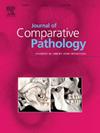Dental and temporomandibular joint pathology of the North American wolverine (Gulo gulo luscus)
IF 0.9
4区 农林科学
Q4 PATHOLOGY
引用次数: 0
Abstract
This study evaluated dental and temporomandibular joint (TMJ) pathology in North American wolverines (Gulo gulo luscus) from coastal southern Alaska, using 182 specimens (43.4 % females, 54.4 % male, 2.2 % unknown) collected across the 20th century. Among the individuals, 2.2 % were classified as young adults, 83.0 % as adults and 14.8 % had an undetermined age. High rates of dental diseases were identified, reflecting patterns seen in other wild carnivores, with acquired conditions occurring more frequently than congenital ones. Periodontitis was the most common pathology (98.9 %), with most cases showing mild severity (stage 2 = 98.9 %). Tooth fractures were identified in over two-thirds of the specimens, with deeper structural damage (complicated crown fractures = 26.2 %, complicated crown-root fractures = 23.1 %, root fractures = 31.3 %) observed more often than enamel fractures, likely due to typical biting behaviour. No significant differences in fracture prevalence were found between sexes (P = 0.3741). Enamel hypoplasia was rare (5.5 %), suggesting minimal systemic stress during dental development. Variations in root numbers were frequently noted (27.5 %), potentially reflecting an adaptive trait for dietary handling. Periapical lesions (9.9 %) were linked to pulp exposure (17.6 %, OR = 49.09, 95 % CI = 28.01–85.22, P <-0.0001), especially in the canine teeth, but were also seen in association with moderate to severe bone loss due to periodontitis (stages 3 and 4 = 65.9 %, OR = 7.75, 95 % CI = 2.20–24.80, P <0.0001). Attrition and abrasion were common (96.1 %), particularly affecting incisor and canine teeth, with a slightly higher incidence in females (U = 2,922, n = 79, n = 99, P = 0.0036), hinting at potential behavioural or dietary differences. TMJ pathology was uncommon (1.6 %) and mild, potentially suggesting that wolverine feeding habits may exert less stress on the joint compared to species with high bite-force diets. Overall, the observed dental and TMJ lesions align with patterns in other wild carnivores, suggesting similar environmental and behavioural influences. Future studies on dietary, genetic and longitudinal health factors could provide deeper insight into the dental adaptations and resilience of North American wolverines in their natural habitats.
北美狼獾牙齿和颞下颌关节的病理学研究
本研究评估了来自阿拉斯加南部沿海的北美狼獾(Gulo Gulo luscus)的牙齿和颞下颌关节(TMJ)病理学,使用了20世纪收集的182个标本(43.4%为雌性,54.4%为雄性,2.2%未知)。其中,2.2%为青壮年,83.0%为成年,14.8%年龄不详。发现了高发病率的牙齿疾病,反映了在其他野生食肉动物中看到的模式,获得性疾病比先天性疾病发生得更频繁。牙周炎是最常见的病理(98.9%),大多数病例表现为轻度严重(2期= 98.9%)。在超过三分之二的标本中发现了牙齿骨折,更深的结构损伤(复杂的冠骨折= 26.2%,复杂的冠-根骨折= 23.1%,根骨折= 31.3%)比牙釉质骨折更常见,可能是由于典型的咬伤行为。性别间骨折发生率无显著差异(P = 0.3741)。牙釉质发育不全是罕见的(5.5%),表明在牙齿发育过程中系统压力最小。根数的变化经常被注意到(27.5%),潜在地反映了对饮食处理的适应性状。根尖周病变(9.9%)与牙髓暴露有关(17.6%,OR = 49.09, 95% CI = 28.01-85.22, P <-0.0001),尤其是犬牙,但也与牙周炎引起的中度至重度骨质流失有关(3期和4期= 65.9%,OR = 7.75, 95% CI = 2.20-24.80, P <0.0001)。磨蚀和磨损是常见的(96.1%),尤其影响门牙和犬齿,女性的发病率略高(U = 2,922, n = 79, n = 99, P = 0.0036),暗示潜在的行为或饮食差异。TMJ病理不常见(1.6%)且轻微,这可能表明与具有高咬力饮食的物种相比,狼獾的进食习惯可能对关节施加更小的压力。总的来说,观察到的牙齿和颞下颌关节病变与其他野生食肉动物的模式一致,表明类似的环境和行为影响。未来对饮食、遗传和纵向健康因素的研究可以更深入地了解北美狼獾在自然栖息地的牙齿适应和恢复能力。
本文章由计算机程序翻译,如有差异,请以英文原文为准。
求助全文
约1分钟内获得全文
求助全文
来源期刊
CiteScore
1.60
自引率
0.00%
发文量
208
审稿时长
50 days
期刊介绍:
The Journal of Comparative Pathology is an International, English language, peer-reviewed journal which publishes full length articles, short papers and review articles of high scientific quality on all aspects of the pathology of the diseases of domesticated and other vertebrate animals.
Articles on human diseases are also included if they present features of special interest when viewed against the general background of vertebrate pathology.

 求助内容:
求助内容: 应助结果提醒方式:
应助结果提醒方式:


